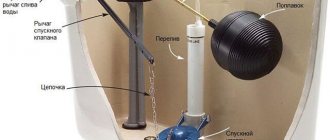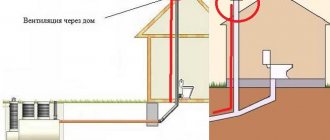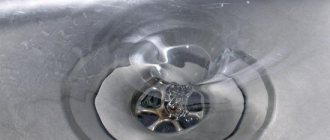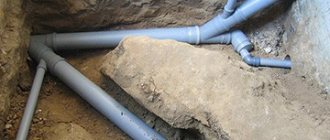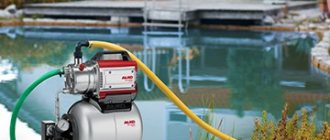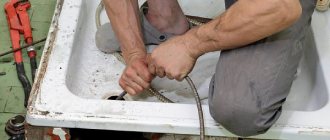Water may gurgle in the sink due to a clog Residents often wonder why water gurgles in the kitchen sink. First of all, it is necessary to blame the blockage both in a separate apartment and in the riser itself. The second place is occupied by a failure at the level of physical interaction between various elements of the sewer system. Finding the source of the problem is possible only if you have certain knowledge regarding the features of the process of fluid flow from one part to another. Often the water “grunts” due to the weak tightness of individual joints. Before taking any measures, a detailed analysis is carried out.
Why it may gurgle in the sink - the main reasons
Most often, the cause of gurgling sounds coming from the sink is air in the sewer pipes. An air lock occurs for the following reasons:
- Violation of sewerage installation rules. Each sewer unit must be equipped with an additional pipe that will prevent water from overflowing. Neglecting the presence of additional pipe elements risks disrupting the operation of the entire sewer system of the apartment.
- Blockage in the risers below, above or at the level of the apartment. The most dangerous situation is a blockage at the bottom. In this case, all the water drained from the upper floors will end up in an apartment with a gurgling sink.
Illumination with a flashlight will allow you to accurately determine the location of the blockage in the siphon.
Causes of sewer gurgling and their elimination
A properly functioning sewer system in an apartment or house does not remind you of itself in any way; the water goes quickly and quietly into the drain, from where it is pumped into the collector. And this should be the case all the time, which is why a complex system of pipelines, sewer risers and other structures is designed. But the complex often malfunctions and gurgling begins in the sink, bathtub, toilet, and sometimes sounds are heard in the pipes, interfering with the usual established comfort. Why this happens and how to eliminate troubles - we’ll talk about this in more detail.
Tips for eliminating gurgling noise in the kitchen
The main advice of plumbers when the first gurgling sounds appear is to immediately find out the cause. Most often, sounds in the kitchen sink are caused by a clogged siphon. First of all, it is necessary to clean this part of the drainage system. The problem is solved in one of the following ways:
- unscrew all parts of the siphon, clean and rinse them;
- pour a special pipe cleaner into the sink drain hole;
- replace the dirty siphon with a new one.
If no blockages are found in the pipes and risers, the gurgling problem will be solved by installing a special tee between the corrugated siphon pipe and the sewer outlet. An air valve is mounted in a vertical socket to increase the air vacuum. After installing the tee, the sounds will disappear and the risk of blockages will be reduced.
One of the reasons for extraneous sounds from the sewer system is a clogged air duct riser on the roof of the building. Often the culprits of this trouble are the residents themselves. Sometimes a bird can get into the pipe. It is necessary to remove the blockage from the roof. You can’t push it inside, it will only make the situation worse.
A popular cause of sewer gurgling is frozen pipes. At extremely low temperatures, the pipe walls become covered with ice, so air access to the sewer is limited. The ice plug is also broken from the roof.
Squelching and gurgling sounds in the kitchen sink are always a harbinger of an impending problem. They cannot be ignored, otherwise unpleasant consequences cannot be avoided. Before choosing a method to solve the problem, you need to study the structure of the sewer system, and it is better to seek help from specialists.
What does biogas consist of?
Most of the sewer system is an empty pipeline system. Inside it, any gases move easily and freely occupy the available volume. In private buildings, such independent structures are connected to settling tanks and special waste containers. Fermentation occurs there, the gradual decomposition of organic substances. With an excessive increase in gas volumes, the pressure in the entire sewer network rapidly increases. If it exceeds the permissible value, then gas enters the home. As a rule, this manifests itself in the same way: an unpleasant odor from the toilet, sink or bathtub, as well as gurgling sounds in the hydraulic valve.
The composition of biogas includes: methane, carbon dioxide, impurities of hydrogen sulfide, ammonia, nitrogen oxides, and other compounds. The first component occupies approximately 63% of the total volume, the rest are significantly less. Moreover, some of the latter are more harmful to health.
Biogas is formed during anaerobic (without air) methane fermentation of biomass Source strojdvor.ru
Bubbling in the sink!
In our kitchen sink we can hear intermittent bubbling, there doesn’t seem to be a blockage and there’s no smell of sewage, I don’t know what to do, we’ve already changed the siphon and it still doesn’t stop; this hasn’t happened before, can anyone advise what to do?
Is there a washing machine or dishwasher drain connected to this outlet? I had this happen when the washing machine was in the kitchen and there was a drain to it (just below the siphon) and there was a gurgling sound when it drained.
It can also happen if the corrugation from the siphon is laid horizontally to the drain (acquaintances have this), but gurgles when the last water leaves.
By chance, did you recently connect an automatic washing machine to the siphon of this sink?
Comfort Shaman – Maniac on a pipe bender.
No, we connected the dishwasher 6 years ago, the gurgling started half a year ago, at first once twice a week, now about twenty times, to be honest, I’m already tired of it.
No, we connected the dishwasher 6 years ago, the gurgling started half a year ago, at first once twice a week, now about twenty times, to be honest, I’m already tired of it.
A photo would show how the drain is organized.
And how far is the riser located?
What else could it be? Most likely the riser at the top is clogged (maybe frozen) and the air is not flowing well. It’s just that the water seal doesn’t rip off completely, but jerks back and forth – the water splashes there.
We have the same bullshit at home.
The siphon is standard plastic, the washing machine is connected separately, since it does not gurgle just during draining.
Gurgles chaotically, at any time. The siphon is located literally 40-50cm from the riser, then only the washing machine drains, there is a separate riser for the bathtub, there is no gurgling there. Sometimes annoying. It gurgles for about 10 seconds and stops, sometimes once a day, sometimes 5 times or more often.
House of 9 floors, built in 1986, kitchen riser.
Judging by the fact that there is no smell, it gurgles in the opposite direction from the apartment, i.e. air is sucked out of the apartment.
I can’t upload a photo, the riser is located next to the drain. When the dishwasher is running, the sink is silent.
Most likely the riser at the top is clogged (maybe frozen) and the air does not flow well. It’s just that the water seal doesn’t rip off completely, but jerks back and forth – the water splashes there.
air is sucked out of the apartment.
In our case, it was most likely clogged, as it gurgles in the summer too.
We moved into this apartment about 4 years ago; this was not the case in the old one.
rather clogged, as it gurgles even in the summer
Sometimes rat birds set up a nest at the outlet of the riser (on the roof) and put all kinds of debris into the pipe, especially if the pipe does not have a head.
When the eggs start falling out of the nests, then will you go figure it out? The location of the central valves, the gas inlet valve, the outlet of the drain and the entrance of the vent pipe into the house would have to be scouted out in 4 years.
In our case, then it was more likely to become clogged
The riser is a problem of the DEZ, write there, they are obliged to clean it.
We have the same bullshit at home.
The siphon is standard plastic, the washing machine is connected separately, since it does not gurgle just during draining.
Gurgles chaotically, at any time. The siphon is located literally 40-50cm from the riser, then only the washing machine drains, there is a separate riser for the bathtub, there is no gurgling there. Sometimes annoying. It gurgles for about 10 seconds and stops, sometimes once a day, sometimes 5 times or more often.
House of 9 floors, built in 1986, kitchen riser.
Judging by the fact that there is no smell, it gurgles in the opposite direction from the apartment, i.e. air is sucked out of the apartment.
IMHO, if it gurgles in the opposite direction, then you can change the siphon to another one that has a stronger water seal.
And by the way, some siphons have an adjustable water seal; the siphon itself simply moves vertically along the pipe.
I can’t upload a photo, the riser is located next to the drain. When the dishwasher is running, the sink is silent.
Is there a corrugation installed between the siphon and the riser? It’s just that if there is a deflection, it may gurgle.
[content-egg module=GdeSlon template=compare]
How to Eliminate Bad Odor from the Kitchen Sink
The smell of fried potatoes with onions, fresh borscht, juicy cutlets - these are the usual kitchen companions. The place where a woman prepares food should be clean and comfortable. And how surprised will you be if you smell sewage from the sink? It is absorbed into clothes and accompanies you everywhere. It's even worse if you're planning a dinner party, which, with the appearance of a nasty smell, will clearly reflect poorly on your reputation. In this article, we will tell you the main causes of odor and gurgling in the sink and help you eliminate this problem once and for all.
Causes of unpleasant odor in the kitchen.
The sink is cleaned to a shine. There are no leftover food anywhere. The dishes are clean. And the smell appears and then disappears again. What is the reason? There are many reasons and they are all different, as well as ways to eliminate the smell from pipes in the kitchen. Sink stench occurs when:
- Mistakes made during sewer installation;
- Incorrect operation of the water seal;
- The occurrence of sewer leaks;
- Insufficient ventilation in the room;
- Pipeline clogged.
Causes of gurgling sounds in the sink
An efficient sewer system never gives cause for unnecessary concern. It is comparable to a clock mechanism; any drainage of water occurs clearly, without delays and unnecessary sounds and smells. But this doesn't always happen.
Bubbling in the sink is a sign of a malfunction in the sewer system
Sewage is a complex system that is often used by people for other purposes. It is this attitude of the residents that can play a cruel joke on them. One of the most common signs is bubbling in the kitchen or bathroom sink. You should know the “enemy in person” in order to take timely appropriate measures to restore the effective operation of the sewerage system.
Why is it important to have a basic understanding of how the sewer system works?
Any sewer network located in a house or high-rise building is a complex system that operates according to certain physical laws. This is a whole complex consisting of special devices, siphons, pipes and risers. All elements are connected into one circuit.
The structure of the sewer network may differ in some of its individual parts, because a private house itself or a multi-storey building are completely different structures. To maintain high-rise buildings, the method of discharging water through a vertical riser is often used. But for a private home, there is no need to use such an element.
It is important to understand everyday issues related to the proper functioning of the sewage system. Indeed, if various problems arise, the participation of the residents themselves in solving them may be required. There is always the opportunity to contact specialists. But sometimes the problem isn't worth it. You can solve it yourself.
Air and its role in the sewerage system
Understanding how the sewer system works is not difficult. Knowing about clear actions in emergency situations is the only destiny of residents. More often than not, most people use the sink, toilet or bathtub without even paying attention to clearly audible problems. And this happens more than one day, or even a week. The gurgling sound from the pipes is perceived as the proper state of affairs. This is precisely where the mistake lies.
A “healthy” sewer system quickly and quietly absorbs wastewater, which it discharges from the sink, bathtub or toilet into a common drain pipe. It is connected to a riser, the end of which goes into a special collector. But not everyone has an idea of what forces drive runoff. The other end of the riser has an outlet to the atmosphere. In multi-storey buildings it is located on the roof, and in private buildings it is located next to the house.
The liquid is discharged using a stream of air drawn into the pipe from the street. Due to the generated pressure, the waste quickly leaves the cavity of the drain pipe and is pushed into the collector. It is this process that is important.
If the sink gurgles, it means a plug has formed.
And it depends on his understanding whether a person can independently cope with possible malfunctions in the sewerage system. And you won’t need to bother anyone with the question: “why is water gurgling in the sink and what should I do?” The answer is clear - a traffic jam has formed. The reason may be:
- pipeline clogging;
- insufficient air in the system.
It remains only to figure out which of the two factors influenced the fact that a growling sound is heard from the sink.
The nuances of the appearance of extraneous sounds from sinks in multi-storey buildings
The first thing that is important in recognizing the nature of the problem is the type of sewer system. In multi-apartment buildings, it has a vertical common riser, which has an exit on the roof of the building itself. Such design differences also affect how the sink gurgles in your kitchen or bathroom.
The larger the pipeline network, the wider the variety of causes of extraneous sounds. The cause of the “accident” can be located both in the apartment itself and among the neighbors. The problem becomes especially serious when the blockage is located outside of it. This is not difficult to calculate. The kitchen bathroom “growls” when:
- The blockage is located in the apartments down the riser. This is the most dangerous version of the problem. It gurgles in the sink only in the early stages of a clog. But if the neighbors above drain the water, and it finds a way out in another apartment, this is already serious. So, the sink fills with waste from other residents and overflows over its edges - onto furniture, floors, etc.
- Blockage in the apartment above. This problem is less dangerous. The sink, toilet and bathtub are safe until the clog itself is removed. After this, a one-time surge in pressure in the pipes is possible, which will lead to a sharp increase in the level of wastewater at the points of the plumbing equipment.
- Blockage at floor level. If the riser is clogged, then the only danger is the water accumulated on top. When removing the blockage, there will be a one-time flow of drainage.
Remedies
Having figured out why the sewer gurgles in a private house, we will consider options for solving this problem. Usually two methods are used:
- installation of a drain pipe;
- installation of a ventilation valve.
Both methods have their pros and cons, so we will consider them separately.
Fan pipe
According to technical rules, the sewer riser should not end on the top floor. It continues higher, passes through the ceilings and roofing and ends at least 50 cm from its surface. The section of the riser located above the topmost outlet is called the fan pipe. It is necessary for ventilation of the pipeline network. Biogas generated in the septic tank of an autonomous system of a private house is freely released into the atmosphere. When water passes through the riser, no vacuum occurs, since the lack of pressure is immediately compensated by the air coming from above.
The need to install a drain pipe is clear to any plumber. However, many would-be masters try to do without it. A bathroom without a vertical pipeline going into the ceiling looks neater; there is no need to build a box or hide the riser in some other way. However, such rationalization leads to excess pressure, when water is drained, the sewer gurgles, and a bad smell appears in the premises. Therefore, refusing to install a drain pipe is a grave mistake.
Valve for system ventilation
The valve for ventilation of pipelines allows you to compensate for excess or insufficient pressure in the system. As a rule, normally closed structures are used in residential premises. They do not allow gas to enter the home, opening only when a vacuum occurs. Air enters the pipes and the risk of water seals breaking is eliminated. There are valves that can not only supply air inside the system, but also dump excess air outside. Such structures are installed only in the attic, and the outlet pipe is connected to a pipe to remove gases outside, outside the attic. Valves are used if it is not possible to install a drain pipe. They are less efficient and there is a possibility of failures.
The outlet (siphon) gurgles on the sink.
I don’t know why, when I release water from the shower stall, the outlet (siphon) on the kitchen sink begins to gurgle. There are no sewer smells, but still unpleasant. What could be causing this? Maybe you need to install another device. The shower stall is located after the sink.
- This means your drain is not assembled quite correctly. The fact is that when you drain water, rarefied air is formed in the drain pipe. Due to the pressure difference, air begins to be drawn into the pipe, in your case from the kitchen, through the siphon. This situation can only happen in two cases: 1) if you have sagging in the drain pipe, which is not good, because they will quickly become clogged.
2) if on the top floor someone closed/removed the pipe to remove “smelly” air. Then it's not scary, but it might stink in the future.
your sewer pipe in your riser is clogged, because of this, when water is drained from the upper floors, it presses down like a piston and displaces water from the siphons, if you're smart, this is called a water seal failure
You are describing a different situation. If a person had the case you are talking about, then there would be a sewer smell in his kitchen. And his air is sucked into the sewer. This means that there is nowhere for air to enter the drain pipe and it is sucked in from the place with the least resistance, in this case from the kitchen siphon.
There was a similar situation with gurgling in the kitchen sink. And also odorless. But after replacing the sewer pipes, the gurgling noise disappeared. Therefore, the possibility of both cases of the alleged VoloshinS and Voda is possible. You should especially be afraid of the possibility of a clogged riser.
[content-egg module=GdeSlon template=compare]
An efficient sewer system never gives cause for unnecessary concern. It is comparable to a clock mechanism; any drainage of water occurs clearly, without delays and unnecessary sounds and smells. But this doesn't always happen.
Bubbling in the sink is a sign of a malfunction in the sewer system
Sewage is a complex system that is often used by people for other purposes. It is this attitude of the residents that can play a cruel joke on them. One of the most common signs is bubbling in the kitchen or bathroom sink. You should know the “enemy in person” in order to take timely appropriate measures to restore the effective operation of the sewerage system.
The sound of a toilet flushing: effective ways to combat noise
03/20/2017Sewerage
A completely silent toilet that does not make any sounds during operation is a phenomenon that is actually not seen in nature. But products that notify not only your apartment, but also a couple of neighboring ones about flushing and adding a new portion of water, can often be found.
But you don’t have to put up with such sound. If the toilet cistern is noisy, it is entirely possible to repair it, or at least reduce the volume to acceptable limits.
Circumstances causing noise
A toilet can make loud noises when operating for many reasons. So before starting repairs, it’s worth taking some time to analyze the situation to find out what we need to fix in the mechanism.
The most common circumstances causing this phenomenon include:
- Problems with the operation of the water supply tap . In most cases, the problem is either the gasket or excessive pressure.
- Foreign objects getting into the diffuser of the hose connecting the faucet to the tank.
- Absence or disconnection of a special pipe that connects to the supply valve in the tank.
Note! This problem is typical for models with side water supply. Products with a bottom connection in most cases do not have a similar drawback: they draw water from the bottom up, and therefore do not gurgle in the initial stages.
- Problems with the overflow mechanism.
- Deposition of salts in the tank , which leads to improper functioning of the shut-off valves.
- Damage to the float , as a result of which it begins to fill with water, making characteristic gurgling sounds.
But these are not the only circumstances that lead to a loud sound: flushing the toilet itself is not too loud, but if you suddenly press the button with the lid open, the echo will increase the volume significantly. And yet, it is within our power to eliminate unnecessary noise, especially since this can be done quite simply.
Tidying up the taps
Instructions for eliminating excessive volume in the toilet recommend starting from the taps:
- The first method - the simplest - involves reducing the pressure when supplying water. Often a valve is enough, and the characteristic humming sounds will completely fall through the ground.
- If this does not help, or as a result the tank begins to fill too slowly, you will need to disassemble the tap. To do this, we turn off the water in the riser, after which we dismantle the device and replace the gasket. As a rule, the hum is caused by worn-out tires, so this procedure helps to cope with the noise.
- The next step is to clean the hose or pipe connecting the water pipe to the tank. To do this, we dismantle this element, remove the fittings from it with installed mesh filters and carefully wash all the parts.
Advice! It is better to wash the hose systematically - then the accumulation of lime will not affect the pressure of water entering the tank.
Tank repair
If the taps and hoses are in order, and the volume does not decrease, you need to fix the tank yourself.
For this:
- Remove the lid from the container by unscrewing the drain button.
- We dismantle the shut-off valves and, if necessary, disconnect the tank itself from the toilet flush.
- We monitor the condition of the rubber seal between the bowl and the tank, smooth it out or replace it if necessary.
- We clean all parts from limescale, paying special attention to moving elements.
- We control the condition of the float. If leaks are detected, we seal the damage or replace the part.
- We carefully clean the supply valve, monitoring its performance. If necessary, screw a hose onto the lower pipe of the toilet flush tank valve so that the incoming water is supplied directly to the bottom of the tank, and does not fall onto it from a great height with a characteristic gurgling sound.
Why is it important to have a basic understanding of how the sewer system works?
Any sewer network located in a house or high-rise building is a complex system that operates according to certain physical laws. This is a whole complex consisting of special devices, siphons, pipes and risers. All elements are connected into one circuit.
The structure of the sewer network may differ in some of its individual parts, because a private house itself or a multi-storey building are completely different structures. To maintain high-rise buildings, the method of discharging water through a vertical riser is often used. But for a private home, there is no need to use such an element.
It is important to understand everyday issues related to the proper functioning of the sewage system. Indeed, if various problems arise, the participation of the residents themselves in solving them may be required. There is always the opportunity to contact specialists. But sometimes the problem isn't worth it. You can solve it yourself.
Why does the water seal on pipes not work?
The complex shape of the siphon and the connection to it was created specially. With its help, a barrier is created to prevent unpleasant odors from penetrating into the house.
The water seal in the pipes represents the water standing in the elbow of each plumbing fixture. When the sewage system in the house is idle for a long time, the liquid evaporates. The pipe does not have a protective plug that prevents pressure drops and the spread of unpleasant odors.
As soon as the use of plumbing equipment becomes regular, the water seal will restore its level. If extraneous sounds persist in the sewer during flushing, you need to continue examining the plumbing equipment. Leaks, depressurization, blockages - a full inspection will be required.
Reasons for water seal failure in normal operation.
- Incorrect choice of pipe diameter. For sewerage, large cross-section lines should always be installed.
- Violation of the slope during installation. Located at an angle to the sewer, the water seal does not hold water and drains it immediately.
- Accumulation of fat deposits, debris, hair, toilet paper. Leads to narrowing of pipes, free circulation of unpleasant odors.
- Formation of lime deposits inside the siphon. The depth level changes. Water does not stay inside the knee, flowing through it further.
- Increased fluid discharge volumes. This is usually associated with home improvement, increasing the number of bathrooms or wet areas.
In these cases, it is necessary to dismantle the damaged area or change all components of the system if the cause of the gurgling is the incorrect choice of diameter.
In a situation with an increased volume of discharges, installing an additional component - an air valve - will help to avoid the failure of the water seal when operating home plumbing. It will artificially regulate the pressure of the system.
Air and its role in the sewerage system
Understanding how the sewer system works is not difficult. Knowing about clear actions in emergency situations is the only destiny of residents. More often than not, most people use the sink, toilet or bathtub without even paying attention to clearly audible problems. And this happens more than one day, or even a week. The gurgling sound from the pipes is perceived as the proper state of affairs. This is precisely where the mistake lies.
A “healthy” sewer system quickly and quietly absorbs wastewater, which it discharges from the sink, bathtub or toilet into a common drain pipe. It is connected to a riser, the end of which goes into a special collector. But not everyone has an idea of what forces drive runoff. The other end of the riser has an outlet to the atmosphere. In multi-storey buildings it is located on the roof, and in private buildings it is located next to the house.
The liquid is discharged using a stream of air drawn into the pipe from the street. Due to the generated pressure, the waste quickly leaves the cavity of the drain pipe and is pushed into the collector. It is this process that is important.
If the sink gurgles, it means a plug has formed.
And it depends on his understanding whether a person can independently cope with possible malfunctions in the sewerage system. And you won’t need to bother anyone with the question: “why is water gurgling in the sink and what should I do?” The answer is clear - a traffic jam has formed. The reason may be:
- pipeline clogging;
- insufficient air in the system.
It remains only to figure out which of the two factors influenced the fact that a growling sound is heard from the sink.
The water in the toilet rises - how to solve the problem
Blockages and other malfunctions of the sewer system occur quite often when using a toilet. Some of them cause the water level in the bowl to rise and, as a result, the toilet overflows water. Below we will look at the reasons why this problem occurs and how to fix it, as well as what other problems may arise in the system.
Clogged toilet
Types of faults
Water in the plumbing may not flow through for only one reason - a clogged sewer. However, in order to fix the problem, you need to figure out why the water is rising in the toilet, or more precisely, where it is coming from.
There can only be two options:
- Drains from the cistern.
- Comes from the sewer.
Below we will look at how to stop the water in the toilet in both cases and remove the blockage.
Removing a blockage using a plunger
Normal clog
If you are faced with a regular blockage, and water enters the toilet from the flush tank, then you should first turn it off to avoid overflow. Why there is water in the toilet is clear to everyone; it all comes down to a blockage in the system.
The nuances of the appearance of extraneous sounds from sinks in multi-storey buildings
The first thing that is important in recognizing the nature of the problem is the type of sewer system. In multi-apartment buildings, it has a vertical common riser, which has an exit on the roof of the building itself. Such design differences also affect how the sink gurgles in your kitchen or bathroom.
The larger the pipeline network, the wider the variety of causes of extraneous sounds. The cause of the “accident” can be located both in the apartment itself and among the neighbors. The problem becomes especially serious when the blockage is located outside of it. This is not difficult to calculate. The kitchen bathroom “growls” when:
- The blockage is located in the apartments down the riser. This is the most dangerous version of the problem. It gurgles in the sink only in the early stages of a clog. But if the neighbors above drain the water, and it finds a way out in another apartment, this is already serious. So, the sink fills with waste from other residents and overflows over its edges - onto furniture, floors, etc.
- Blockage in the apartment above. This problem is less dangerous. The sink, toilet and bathtub are safe until the clog itself is removed. After this, a one-time surge in pressure in the pipes is possible, which will lead to a sharp increase in the level of wastewater at the points of the plumbing equipment.
- Blockage at floor level. If the riser is clogged, then the only danger is the water accumulated on top. When removing the blockage, there will be a one-time flow of drainage.
In the apartment where the pipes are clogged, repair work is required. Usually, specialists are called to the site and, using a special cable, clean problem areas of the pipeline. But if, even after the work, the sound does not disappear, then the problem becomes more serious. If a blockage occurs systematically in the same place, then the problem area needs to be replaced with a new one.
Biogas pressure
Sometimes owners install independent drainage systems with their own hands. But in order to ensure the proper functioning of the septic tank, certain knowledge is required. Due to their absence, the container sometimes turns out to be hermetically sealed, devoid of ventilation. As a result of waste decomposition, biogas is released, which subsequently creates pressure inside the pipeline network. It begins to negatively affect plumbing siphons.
After draining the water, the volume of the latter increases, and at the same time gas accumulations are displaced. As a result, the pressure inside the system increases, a certain amount of gas overcomes the hydraulic seal and comes out. For this reason, the sewage system gurgles in the bathroom or other plumbing fixtures, since their constituent elements could not resist the gas pressure. This process usually results in the appearance of an unpleasant odor. The described problem can be eliminated using technical methods.
A water seal is a curved pipe that holds water, preventing the penetration of gases from the sewer network into the room Source remoo.ru
It happens that the drain sloshes loudly in the sink or bathtub even without draining. At such a moment, the volume of accumulated gases exceeds the permissible limits, and some of them penetrate through the water layer. This often happens in devices with small outlets, which are not always able to provide the necessary resistance. For example, modern plastic water seals designed for bathtubs have a small drop. It is easily overcome even by slight pressure of waste gases.
The main problem in the situations described is incorrect assembly of the system. The real root cause why the toilet gurgles in the bathroom when flushed is hidden in the complete tightness of the pipelines, as well as the lack of ventilation. As a rule, such a technical miscalculation is allowed at the stage of creating a project or during installation work.
As soon as it becomes obvious that the sink or toilet is “squelching”, you must immediately call a specialist Source i.ytimg.com
Proper installation of plumbing is the key to peace of mind for all residents
Extraneous sounds from the sink are just the “first bell” of problems. But what can inaction lead to? The gurgling, at one moment, can develop into a flood.
So, through the sink, toilet and sewer outlet under the washing machine, the drains will “spout out” and completely cover the floor. The first thing you have to do is remove this unpleasant-smelling slurry with your own hands. And it will also add trouble to the neighbors below. Their ceiling may also suffer. Therefore, it is important to solve the problem immediately, without postponing it for the future.
A gurgling sink may indicate improper plumbing installation.
But is the situation really so hopeless? There is always a way out. Often, the sounds that come from the kitchen sink are the “fruits” of improper installation of plumbing. So, not every bathroom is equipped with an additional pipe that prevents water from leaving its boundaries.
More often than others, the problem is the toilet. People often save on purchasing additional elements and install the devices themselves. Such neglect is a big risk for multi-storey buildings. You can harm not only your home, but also your neighbors below.
Harm from sewer gases
If sewer is blowing from the sink, you need to react immediately. This is not just an unpleasant situation, the problem is much deeper and more dangerous. Biogas is a mixture of several components, including:
- methane;
- hydrogen sulfide;
- carbon dioxide;
- ammonia;
- hydrogen and other components.
Each of these gases is harmful to humans in its own way. It is necessary to take into account that the mixture has its own properties that are more dangerous for people. Biogas is heavier than air and tends to collect above the floor of rooms. The first animals to suffer from this are cats and dogs.
In addition to being harmful to health, biogas is dangerous in terms of fire. It is flammable and can explode at a certain concentration. Accumulating at floor level, it can ignite from any spark. The consequences of this can be very sad. The flow of gases does not always occur quite intensively; they often penetrate in small portions. However, even small amounts are dangerous for people, as they contribute to headaches, interfere with concentration, and cause general malaise. It is unlikely that you can directly die from them, as some sources claim, but less intense exposure is undesirable.
Also read: Connecting a bidet to the sewer: diagram, how to connect, which terminal, connection overview
What the professionals say
Plumbers' advice is based on one rule. When you hear sounds, there is a problem. Don't put off solving the problem until later. And the blockage is not always located somewhere far away. Often the problem area is the siphon connecting the plumbing to the pipeline.
There may not be enough air to discharge the water or a gap may form on the corrugated walls of the pipe. If there is an air problem, plumbers recommend raising the pipe higher.
The sounds should stop. But if not, then that’s not the problem. There are several ways out:
- Unscrew all structural elements of the siphon and wash them. It will be difficult to do this with a pipe, as there is a risk that the blockage will remain.
- Use specialized tools. Modern pipe cleaning products can cope with any type of blockage. They are not a threat to the siphon itself. The accumulated garbage is dissolved under the influence of a toxic substance and discharged into pipes.
- Replace the dirty siphon with a new one. This method is suitable for those who do not spare money for a new device.
- Equip the sink drain with a straight pipe. If the corrugated pipe quickly becomes clogged, then with a straight element there will be fewer problems.
Another option is suitable only for sinks, sinks and bathtubs. You can get rid of sounds using a special tee. It must be installed as a connecting element between the corrugated siphon pipe and the pipeline.
The remaining nest should be positioned vertically. An air valve is installed in it, which is intended to increase the vacuum. By installing such a tee, not only the sounds from lack of air can go away, but the risk of signs of blockage will also be significantly reduced.
Video description
Fan riser device.
Ventilation valve
A valve is used to compensate for insufficient or excess pressure in the waste system. Typically, completely enclosed structures are installed inside private buildings. The latter do not allow gas to penetrate into the home; they open only when a vacuum occurs. In the meantime, a sufficient amount of air enters the pipes, and the likelihood of hydraulic valves breaking disappears.
There are valves that allow air masses to enter the system and also release excess air to the outside. Such structures are installed exclusively in the attic: the outlet pipe is connected to the pipeline in order to remove gases outside the attic.
Attention! Valves are used only when it is completely impossible to use a drain pipe. This is due to their lower efficiency and high risk of failure.
An aerator (air valve) is a small round device that is mounted on a sewer pipe in a vertical position Source i.ytimg.com
The main causes of air jams in sewer risers of multi-storey buildings
Sewerage problems do not always arise from the residents of a high-rise building themselves. Sometimes accidents happen from which no one is safe. So, birds often get into the pipeline.
With her body, she easily blocks the access of air. The problem can only be eliminated from the roof of the building by pulling it out manually or using special tools. The cable is not helpful in this matter. With its help you can only push the bird inside, and only make the situation worse. The deeper the plug is, the more difficult it is to get rid of it. Therefore, you should choose the right tool for such work.
Another popular reason is frozen pipes. In winter, when the outside temperature is low and the wastewater is warm, frostbite may occur on the walls. If there is complete icing, it is also necessary to climb onto the roof of the building in order to remove the plug.
Freezing pipes and other factors
The randomness factor cannot be foreseen or prevented. Even if all residents follow the rules for operating the system, problems still occur. The list opens with a bird that got into the ventilation shaft of the sewer system. As the volume of air entering the toilet decreases, a distinct gurgling sound is heard when flushing. Only an experienced plumber can remove the bird.
Before disassembling the pipe, place a container
The second common reason is frozen pipes.
Events develop as follows:
- An imbalance is created when the air temperature is low and the water temperature in the tubes is high;
- Frostbite on the internal surface of the system gradually increases;
- The plug forms within 4-5 days;
- It can only be removed while on the roof.
Even if you follow all the rules for operating the system, it is not always possible to avoid problems. If the results of the inspection indicate that it is possible to exclude a situational factor, for example, a traffic jam caused by neighbors, then you need to immediately check the factor of chance.

